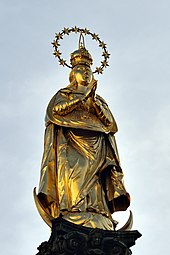At the Iron Gate (Graz)

The square at the Iron Gate is a triangular space between plant Opernring and Herrengasse in the first Grazer District Inner City and was named after the former city gate. Important sights are the fountain (1928) by Tassilo Hüller and the Marian column. Between 2003 and 2007, the so-called Marienlift stood right next to the Marian column .
Iron gate
In the 15th century, an early gate marked the breakthrough through the old wall of the Graz Jewish Ghetto, which turned Herrengasse , which at the time was still Bürgergasse , into a blind alley. After the abolition of the ghetto in 1439, the construction of the building began. The Iron Gate, also called Ungartor, got its name either from the iron gate wing or the iron weapons stored in the building. The origin of the designation can no longer be reliably determined. A corruption of the word “outer” to “iron” is also conceivable.
Because of the expansion of the city to the south, the old gate had to be demolished. In the middle of the 16th century, the construction of the late Renaissance fortification belt began under the direction of the fortress builder Domenico dell'Allio , the builder of the Graz country house . The new location of the Iron Gate, which resembled the outer Paulustor , was at the height of Hans-Sachs-Gasse . Police were held in the building itself. In front of the gate a wooden bridge led over the former moat. The construction of the Ringstrasse in the 19th century and the dissolution of the fortification belt led to the final demolition of the Iron Gate in 1859 and 1860. The plaza of the same name reminds of its existence today.
Marian column
The Marian column (also called the Turkish column) forms an ensemble with the fountain at the Iron Gate . It stands at the southern end of the line of sight from Herrengasse . The votive column was completed in 1670 and is the redemption of a vow made on August 1, 1664 at the time of the Turkish wars after the victorious battle of Mogersdorf under Count Raimondo Montecuccoli . The design of the column, which is dedicated to the Immaculate Conception of Mary , is attributed to Domenico Sciassia , the stone carvings are by Abbondia Bolla and the cast of the column shaft is by Adam Roßtauscher. Arnold Schandernell from Augsburg was responsible for the work on the copper statue.
Originally the Karmeliterplatz built, St. Mary's column was in 1796 at the expense of Kaspar Andreas von Jacomini to Jakominiplatz transmitted and 1927 removed. The location was roughly where the trams of lines 1, 3, 6 and 7 run today. According to the plans of Tassilo Hüller, who also designed the fountain at the Iron Gate, the column was placed in its current location in 1928.
The column rests on a square base made of Salzburg marble above a stepped platform. Four cartridges with inscriptions are attached above. On the Corinthian bronze column stands the gilded figure of Maria Immaculata, which gives it its name and was modeled on the Marian column Am Hof erected in Vienna in 1646 .
literature
- Horst Schweigert: DEHIO Graz . Schroll, Vienna 1979, ISBN 3-7031-0475-9 , p. 57 and 111 .
- Robert Engele: The gate guard house is now a nice café . From the series Damals in Graz in the Styrian edition of the Kleine Zeitung of October 23, 2011. pp. 42–43.
- Karl A. Kubinzky, Astrid M. Wentner: Grazer street names. Origin and meaning . Leykam, Graz 1996, ISBN 3-7011-7336-2 , pp. 24 .
Web links
Individual evidence
- ^ Schweigert: Dehio Graz. P. 57.
- ↑ Robert Engele: The gate guard house is now a nice café . From the series At that time in Graz in the Styrian edition of the Kleine Zeitung of October 23, 2011. p. 42.
- ^ Karl A. Kubinzky: Grazer street names. Origin and meaning . Graz: Leykam 1996, p. 24.
- ↑ Robert Engele: The gate guard house is now a nice café . From the series At that time in Graz in the Styrian edition of the Kleine Zeitung of October 23, 2011. p. 43.
- ↑ a b c Schweigert: Dehio Graz. P. 111.
Coordinates: 47 ° 4 ′ 5.9 ″ N , 15 ° 26 ′ 30.7 ″ E



